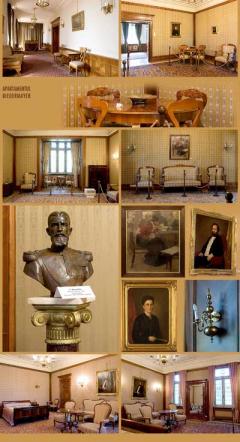Apartamentul Biedermeyer - Muzeul Naţional Cotroceni
Etajul II
Daca, în Muzeul National Cotroceni, un accent aparte s-a pus pe restaurarea interioarelor ramase intacte sau aproape intacte, probleme deosebite au ridicat acele încaperi radical modificate în timp, încercându-se pe cât posibil ca, prin solutiile arhitecturale adoptate, sa se pastreze ideea compozitionala initiala.
La aceasta categorie de încaperi, în care martorii de epoca au fost sensibil mai saraci sau chiar au lipsit, s-a optat pentru solutia recompunerii atmosferei decorative specifice sfârsitului de secol XIX si inceputului celui de-al XX-lea.
Comenzile masive facute de Casa Regala înca din 1895 firmelor straine, având ca furnizori principali pe cele din Germania (Berlin, Hamburg, Munchen), explica volumul apreciabil de mobilier sobru neorenascentist aflat azi în patrimoniul muzeului. Distribuirea si amplasarea lui în apartamente - diferita desigur de amenajarile initiale - a tinut cont în primul rând de solutiile adoptate la restaurare, mobilierul, pe tot parcursul expunerii, facând permanent rapel interiorului în care a fost plasat.
(Extrase din ghidul Muzeului National Cotroceni)
The Second Floor
Whereas in the Cotroceni National Museum the restoration of intact and almost intact interiors was especially taken care of, bigger problems came from the rooms that radically changed in time, the restorers trying to find architectural solutions that should keep the initial compositional idea as much as possible. In the case of this category of rooms, which lacked eyewitnesses almost completely, the restorers decided upon recomposing the decorative atmosphere specific to the end of the 19th century and the beginning of the 20th century.
The massive commissions given by the Royal House to foreign firms since 1895, having as main suppliers the German ones (Berlin, Hamburg, Munich) account for the considerable amount of sober neo-Renaissance furniture that is now to be found in the museum collections.
Its distribution and positioning in the apartments – which differred, of course, from the initial arrangement – took into account particularly the solutions chosen for restoration, as the furniture was permanently chosen so as to match the interior in which it was placed.
(Excerpts from The Cotroceni National Museum Guide)






















